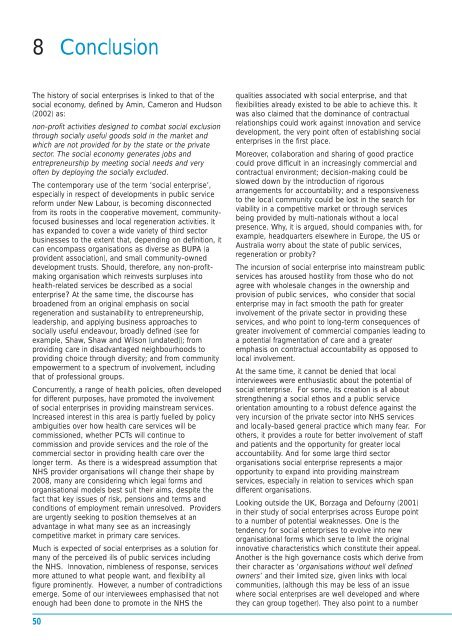Social Enterprises and the NHS - Unison
Social Enterprises and the NHS - Unison
Social Enterprises and the NHS - Unison
You also want an ePaper? Increase the reach of your titles
YUMPU automatically turns print PDFs into web optimized ePapers that Google loves.
8 Conclusion<br />
The history of social enterprises is linked to that of <strong>the</strong><br />
social economy, defined by Amin, Cameron <strong>and</strong> Hudson<br />
(2002) as:<br />
non-profit activities designed to combat social exclusion<br />
through socially useful goods sold in <strong>the</strong> market <strong>and</strong><br />
which are not provided for by <strong>the</strong> state or <strong>the</strong> private<br />
sector. The social economy generates jobs <strong>and</strong><br />
entrepreneurship by meeting social needs <strong>and</strong> very<br />
often by deploying <strong>the</strong> socially excluded.<br />
The contemporary use of <strong>the</strong> term ‘social enterprise’,<br />
especially in respect of developments in public service<br />
reform under New Labour, is becoming disconnected<br />
from its roots in <strong>the</strong> cooperative movement, communityfocused<br />
businesses <strong>and</strong> local regeneration activities. It<br />
has exp<strong>and</strong>ed to cover a wide variety of third sector<br />
businesses to <strong>the</strong> extent that, depending on definition, it<br />
can encompass organisations as diverse as BUPA (a<br />
provident association), <strong>and</strong> small community-owned<br />
development trusts. Should, <strong>the</strong>refore, any non-profitmaking<br />
organisation which reinvests surpluses into<br />
health-related services be described as a social<br />
enterprise? At <strong>the</strong> same time, <strong>the</strong> discourse has<br />
broadened from an original emphasis on social<br />
regeneration <strong>and</strong> sustainability to entrepreneurship,<br />
leadership, <strong>and</strong> applying business approaches to<br />
socially useful endeavour, broadly defined (see for<br />
example, Shaw, Shaw <strong>and</strong> Wilson (undated)); from<br />
providing care in disadvantaged neighbourhoods to<br />
providing choice through diversity; <strong>and</strong> from community<br />
empowerment to a spectrum of involvement, including<br />
that of professional groups.<br />
Concurrently, a range of health policies, often developed<br />
for different purposes, have promoted <strong>the</strong> involvement<br />
of social enterprises in providing mainstream services.<br />
Increased interest in this area is partly fuelled by policy<br />
ambiguities over how health care services will be<br />
commissioned, whe<strong>the</strong>r PCTs will continue to<br />
commission <strong>and</strong> provide services <strong>and</strong> <strong>the</strong> role of <strong>the</strong><br />
commercial sector in providing health care over <strong>the</strong><br />
longer term. As <strong>the</strong>re is a widespread assumption that<br />
<strong>NHS</strong> provider organisations will change <strong>the</strong>ir shape by<br />
2008, many are considering which legal forms <strong>and</strong><br />
organisational models best suit <strong>the</strong>ir aims, despite <strong>the</strong><br />
fact that key issues of risk, pensions <strong>and</strong> terms <strong>and</strong><br />
conditions of employment remain unresolved. Providers<br />
are urgently seeking to position <strong>the</strong>mselves at an<br />
advantage in what many see as an increasingly<br />
competitive market in primary care services.<br />
Much is expected of social enterprises as a solution for<br />
many of <strong>the</strong> perceived ills of public services including<br />
<strong>the</strong> <strong>NHS</strong>. Innovation, nimbleness of response, services<br />
more attuned to what people want, <strong>and</strong> flexibility all<br />
figure prominently. However, a number of contradictions<br />
emerge. Some of our interviewees emphasised that not<br />
enough had been done to promote in <strong>the</strong> <strong>NHS</strong> <strong>the</strong><br />
50<br />
qualities associated with social enterprise, <strong>and</strong> that<br />
flexibilities already existed to be able to achieve this. It<br />
was also claimed that <strong>the</strong> dominance of contractual<br />
relationships could work against innovation <strong>and</strong> service<br />
development, <strong>the</strong> very point often of establishing social<br />
enterprises in <strong>the</strong> first place.<br />
Moreover, collaboration <strong>and</strong> sharing of good practice<br />
could prove difficult in an increasingly commercial <strong>and</strong><br />
contractual environment; decision-making could be<br />
slowed down by <strong>the</strong> introduction of rigorous<br />
arrangements for accountability; <strong>and</strong> a responsiveness<br />
to <strong>the</strong> local community could be lost in <strong>the</strong> search for<br />
viability in a competitive market or through services<br />
being provided by multi-nationals without a local<br />
presence. Why, it is argued, should companies with, for<br />
example, headquarters elsewhere in Europe, <strong>the</strong> US or<br />
Australia worry about <strong>the</strong> state of public services,<br />
regeneration or probity?<br />
The incursion of social enterprise into mainstream public<br />
services has aroused hostility from those who do not<br />
agree with wholesale changes in <strong>the</strong> ownership <strong>and</strong><br />
provision of public services, who consider that social<br />
enterprise may in fact smooth <strong>the</strong> path for greater<br />
involvement of <strong>the</strong> private sector in providing <strong>the</strong>se<br />
services, <strong>and</strong> who point to long-term consequences of<br />
greater involvement of commercial companies leading to<br />
a potential fragmentation of care <strong>and</strong> a greater<br />
emphasis on contractual accountability as opposed to<br />
local involvement.<br />
At <strong>the</strong> same time, it cannot be denied that local<br />
interviewees were enthusiastic about <strong>the</strong> potential of<br />
social enterprise. For some, its creation is all about<br />
streng<strong>the</strong>ning a social ethos <strong>and</strong> a public service<br />
orientation amounting to a robust defence against <strong>the</strong><br />
very incursion of <strong>the</strong> private sector into <strong>NHS</strong> services<br />
<strong>and</strong> locally-based general practice which many fear. For<br />
o<strong>the</strong>rs, it provides a route for better involvement of staff<br />
<strong>and</strong> patients <strong>and</strong> <strong>the</strong> opportunity for greater local<br />
accountability. And for some large third sector<br />
organisations social enterprise represents a major<br />
opportunity to exp<strong>and</strong> into providing mainstream<br />
services, especially in relation to services which span<br />
different organisations.<br />
Looking outside <strong>the</strong> UK, Borzaga <strong>and</strong> Defourny (2001)<br />
in <strong>the</strong>ir study of social enterprises across Europe point<br />
to a number of potential weaknesses. One is <strong>the</strong><br />
tendency for social enterprises to evolve into new<br />
organisational forms which serve to limit <strong>the</strong> original<br />
innovative characteristics which constitute <strong>the</strong>ir appeal.<br />
Ano<strong>the</strong>r is <strong>the</strong> high governance costs which derive from<br />
<strong>the</strong>ir character as ‘organisations without well defined<br />
owners’ <strong>and</strong> <strong>the</strong>ir limited size, given links with local<br />
communities, (although this may be less of an issue<br />
where social enterprises are well developed <strong>and</strong> where<br />
<strong>the</strong>y can group toge<strong>the</strong>r). They also point to a number















